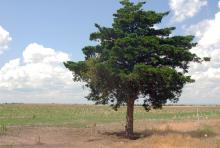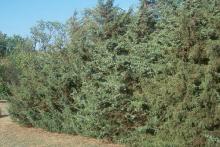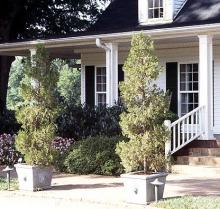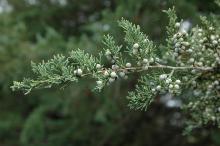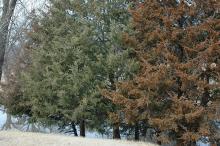Juniperus virginiana
Common name:
Eastern Redcedar
Pencil Cedar
Pronunciation:
ju-NIP-er-us ver-jin-ee-A-na
Family:
Cupressaceae
Genus:
Type:
Conifer
Native to (or naturalized in) Oregon:
No
- Conifer, evergreen tree, 40-50 ft (12-15 m) high, densely pyramidal when young, slightly pendulous with age; variable in habit. Bark gray to red-brown, exfoliating in long strips. Leaves may be needles or scale-like, needles are sharp, awl-shaped, to 12 mm long and in whorls of three, found on older trees, scale leaves are opposite, arranged in 4 ranks, closely pressed and overlapping, 1.5-2.0 mm long, medium green in summer and dirty green, brown in winter, needles and scale leaves often on the same branch, bruised leaves have cedar chest odor. Usually dioecious - male and female trees. Fruit (seed cones, "berries"), 6 mm wide, dark blue with a whitish bloom, 1-3 seeded, ripen in autumn in their first year.
- Sun Tolerant of adverse conditions, but prefers a deep, moist, well-drained loam soil.
- Hardy to USDA Zone 2 Native to eastern and central North America to Rocky Mountains; the most widely distributed conifer of the eastern U.S. and the only juniper species east of the Mississippi River. At least three botanical varieties are recognized (J. v. var. virginiana, var. crebra , and var. ambigens). Eastern Redcedar hybridizes with many other juniper species, including the closely related Rocky Mountain juniper (J. scopulorum), as well as J. mexicana, J. chinensis, creeping juniper (J. horizontalis), southern redcedar (J. silicicola), and Ashe juniper (J. ashei).
-
Many selections have been or are commercially available, including:
- ‘Blue Arrow’ - narrow growth habit, to 12-15 ft tall, 2 ft wide (~3.6-4.5 ×0.6 m), blue-green foliage.
- ‘Burkii’ - excellent blue foliage that turns purple in winter, male, pyramidal, to 15-25 ft (4.5-7.5 m) tall.
- ‘Canaertii’ - compact pyramidal form, 15-20 ft (4.5-6 m) tall, opens with age becoming picturesque, dark green foliage, abundant, small cones with whitish bloom.
- Emerald Sentinel™ - columnar, emerald green all year, 15-20 ft (4.5-6 m) tall,.
- ‘Glauca’ - columnar form, narrow, to 25 ft (7.5 m), blue-green foliage, silver-blue in spring.
- ‘Grey Owl’ - found in a batch of J. virginiana ‘Glauca’ seedlings, possibly a hybrid between ‘Glauca’ and J. chinensis ‘Pfitzeriana’. Often listed as Juniperus 'Grey Owl'.
- ‘Hillii’ - dense and columnar, slow growing to 15-20 ft (4.5-6 m), leaves awl-shaped with a bluish-white band above, greenish-blue below, foliage pale bluish-green turning purplish-plum in fall, a male.
- ‘Hillspire’ (‘Cupressifolia’ ) - male, columnar or pyramidal, 20 ft (6 m) or more, dark green even in winter.
- ‘Manhattan Blue’ - compact broad pyramid, 15-20 ft (4.5-6 m) tall, bluish-green foliage, female.
- ‘Pendula’ - weeping habit derived from drooping branchlets and secondary branches, may attain as height of over 30 ft tall (10 m). Possibly more than one clone sold under this name.
- ‘Skyrocket’ - very narrow spire, to 25 ft (7.5 m), only 2-3 ft (0.6-0.9 m) wide, blue-gray foliage; male. Some specimens are not slender, possibly because of growing conditions or propagation method (Jacobson, 1996). 'Skyrocket' was once classified under J. scopulorum and later assigned to the J. virginiana. 'Blue Arrow' is considered an improved form of "Skyrocket'.

